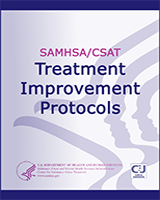NCBI Bookshelf. A service of the National Library of Medicine, National Institutes of Health.
This publication is provided for historical reference only and the information may be out of date.
This Treatment Improvement Protocol (TIP) is intended to examine the physical and psychosocial sequelae associated with the abuse of opioids in combination with cocaine and offer assessment and treatment planning protocols for staff to use in substance abuse treatment programs.
To the extent possible, the document is based on available research information. However, many of the clinical issues facing providers of treatment to concurrently dependent persons have yet to be fully assessed. Few data exist on treating concurrent cocaine abuse, and even less information exists on treating concurrent abuse of other stimulants. This TIP is a reflection of the treatment modalities that are being used in various treatment centers throughout the Nation and should be viewed as such, rather than as a document that purports to have definitive solutions to what has become an extraordinarily difficult problem. Where clinical research is lacking, the TIP makes recommendations for treatment strategies based on clinical models developed by successful treatment programs. These recommendations should be considered guides, and their use should be tailored to the specific needs of an individual program's patient population.
Contents
- What Is a TIP?
- Consensus Panel
- Foreword
- Note From the Chair
- Chapter 1-Overview
- Chapter 2-Statement of the Problem
- Chapter 3-Screening, Admission, and Assessment Techniques
- Chapter 4-Treatment Interventions and Related Issues
- Chapter 5-Legal and Ethical Issues
- Chapter 6-Evaluating Program Performance
- Chapter 7-Consensus Panel Recommendations for Further Research
- Appendix A - Glossary
- Appendix B - Levels of Care
- Appendix C - Acronyms
- Appendix D - TB/PPD Testing - Sample Forms
- Appendix E - Multidrug Abuse Patterns
- Appendix F - Diagnostic Assessment Instruments
- Appendix G - DSM-IV Criteria for Substance-Related Disorders
- Appendix H - Psychiatric Disorders
- Appendix I - Internal Trigger Questionnaire and External Trigger Questionnaire
- Appendix J - Self-Help Groups
- Appendix K - Federal Resource Panel
- Appendix L - Field Reviewers
- References
This publication is part of the Substance Abuse Prevention and Treatment Block Grant technical assistance program. This publication was written under contract number ADM 270-91-0004 from CSAT. Robert Lubran served as the Government project officer. Lynne C McArthur, Yvonne P Goldsberry, Yvonne daSilva, Anita Winters, Rebecca Horton, and Diana Schwartz served as contractor writers.
The opinions expressed herein are those of the Consensus Panel members and do not reflect the official position of the Substance Abuse and Mental Health Services Administration (SAMHSA) or any other part of the U.S. Department of Health and Human Services (DHHS). No official support or endorsement of SAMHSA or DHHS is intended or should be inferred. The guidelines proffered in this document should not be considered as substitutes for individualized patient care and treatment decisions.
- Review Treatment for Stimulant Use Disorders[ 1999]Review Treatment for Stimulant Use DisordersCenter for Substance Abuse Treatment. 1999
- Health profiles of clients in substance abuse treatment: a comparison of clients dependent on alcohol or cocaine with those concurrently dependent.[Subst Use Misuse. 2014]Health profiles of clients in substance abuse treatment: a comparison of clients dependent on alcohol or cocaine with those concurrently dependent.Macdonald S, Pakula B, Martin G, Wells S, Borges G, Roth E, Salmon A, Stockwell T, Callaghan RC. Subst Use Misuse. 2014 Dec; 49(14):1899-907. Epub 2014 Aug 6.
- Issues in subject recruitment and retention with pregnant and parenting substance-abusing women.[NIDA Res Monogr. 1996]Issues in subject recruitment and retention with pregnant and parenting substance-abusing women.Howard J, Beckwith L. NIDA Res Monogr. 1996; 166:68-86.
- Substance use in pregnancy.[J Obstet Gynaecol Can. 2011]Substance use in pregnancy.Wong S, Ordean A, Kahan M, MATERNAL FETAL MEDICINE COMMITTEE, FAMILY PHYSICIANS ADVISORY COMMITTEE, MEDICO-LEGAL COMMITTEE, AD HOC REVIEWERS, SPECIAL CONTRIBUTORS. J Obstet Gynaecol Can. 2011 Apr; 33(4):367-384.
- Opioids and the management of chronic severe pain in the elderly: consensus statement of an International Expert Panel with focus on the six clinically most often used World Health Organization Step III opioids (buprenorphine, fentanyl, hydromorphone, methadone, morphine, oxycodone).[Pain Pract. 2008]Opioids and the management of chronic severe pain in the elderly: consensus statement of an International Expert Panel with focus on the six clinically most often used World Health Organization Step III opioids (buprenorphine, fentanyl, hydromorphone, methadone, morphine, oxycodone).Pergolizzi J, Böger RH, Budd K, Dahan A, Erdine S, Hans G, Kress HG, Langford R, Likar R, Raffa RB, et al. Pain Pract. 2008 Jul-Aug; 8(4):287-313. Epub 2008 May 23.
- Assessment and Treatment Planning for Cocaine-Abusing Methadone-Maintained Patie...Assessment and Treatment Planning for Cocaine-Abusing Methadone-Maintained Patients
Your browsing activity is empty.
Activity recording is turned off.
See more...

